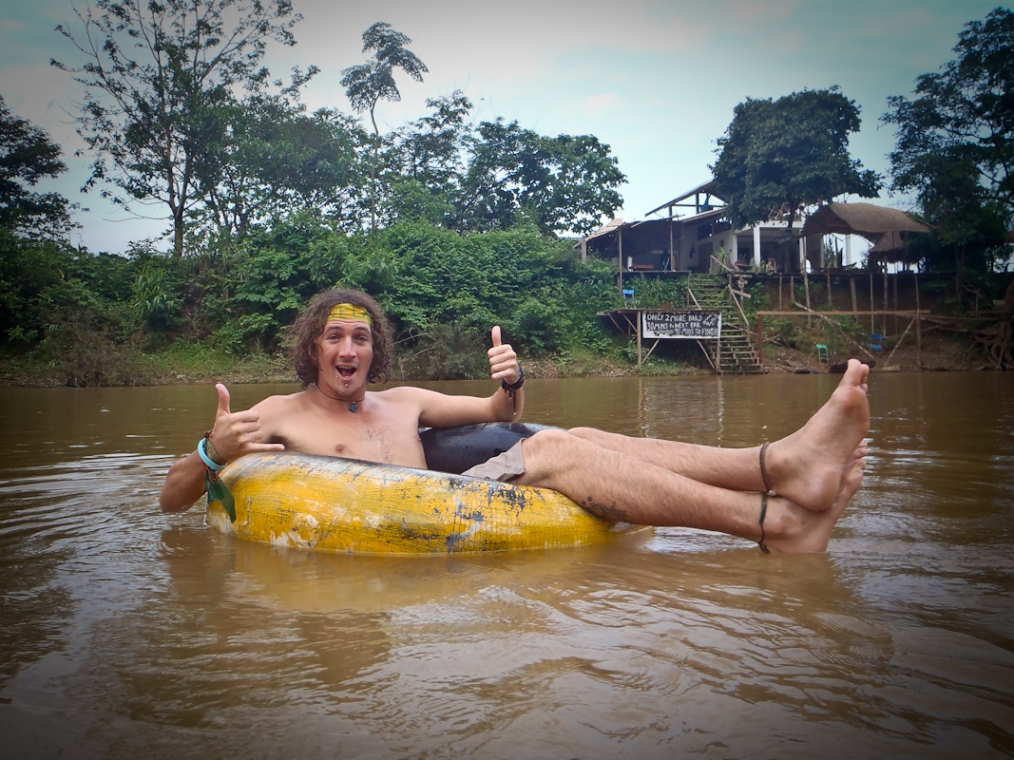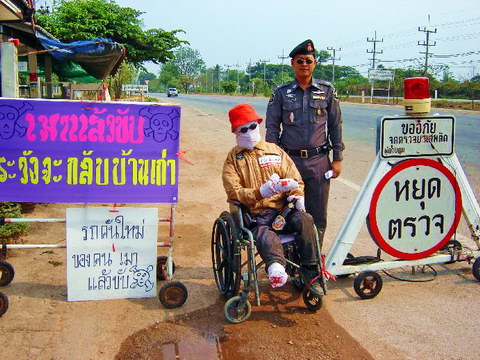by Chris Tharp
(This is the time of year where many of us head to SE Asia on vacation. I haven’t been able to for the past couple of winters and am rightfully bitter about it it, so allow me to continue what has become a Sweet Pickles & Corn tradition and post a cynical list in order to convince myself that I’m happy to be in drab old Korea right now. This piece was originally run on my currently dormant personal blog Homely Planet about three years back. Enjoy.)
One of the best things about living in Korea is the fact that it’s actually on the continent of Asia. There are countless exotic travel destinations just a relatively quick flight away. Topping the list for me and many others are the countries that make up the Southeast. I mean, what’s not to love? They’ve got hot weather, happy people, beaches, rivers, waterfalls, cold beer, atomic cuisine and enough vice to make Las Vegas look like Salt Lake City. At any time I can grab my backpack, jump on a plane, and shoot straight out of the Land of Scowls into the The Realm of Infinite Smiles. I love Southeast Asia and my record proves it: I’ve been a regular visitor for eight years running and don’t plan on stopping any time soon.
However… all is not perfect in paradise. I could wax ad infinitum about how awesome the region is, but that would be no fun, and I would be doing all of us a disservice. Southeast Asia is a traveler’s heaven, but with that comes a lot of asshats, annoyances, fuckwittery and general ballaches to make me want to burn my passport and move back to some awful place like Iowa or Everett, Washington. Here’s a list of well-formed gripes, in no particular order of suck:
1. FIRE SHOWS

The first couple times I saw fire shows I thought they were pretty sweet. This was back in the 90’s in Seattle, where they were performed by my freaky friends with pierced eyebrows, face tattoos, and those silly tribal earlobe plugs. These performances were kind of edgy, slightly dangerous, and definitely sexy. I thought they were cool… until some years later when I went to Thailand and spent a week on a beach, where on a nightly basis, there were slightly less fire shows than grains of sand . Cow-eyed tourists formed semi-circles around sinewy locals swinging flaming balls and oohed and ahhed like they were watching a 4th of July Fireworks display or witnessing a French nuclear test. Awful music blared from each little spectacle, mingling together into one uber-din that was about as peaceful and relaxing as the Invasion of Normandy.
What’s even worse is that I saw some tourists trying to take up the “art form”. I really wanted all them to set their hair aflame. Nothing’s funnier to me than a Swede on fire.
2. HENNA TATOOS
When I was a kid I used to play army in the woods. This was before American children were robbed of their childhood by smart phones, bike helmets, and neurotic, overprotective soccer moms. On the way back home, after one of our epic battles, we’d stop at the little store by our houses and buy bubble gum, Near Beer, candy cigarettes (yes, they existed) and Crackerjacks. The best thing about the Crackerjacks was the “toy surprise” found in every box. Sometimes it was a tiny car or plastic magnifying glass–but the best one was the little tattoo that you could apply with just a bit of spit. The cheap, water-soluble ink would stay on your arm for a day or so and seemed really awesome at the time… but then again, I was nine.

Henna tattoos aren’t so different than ones found in a box of Crackerjacks, only they’re sported by full-grown backpacker chicks who aren’t daring enough to get real ink in their actual lives back at home. After all, if the tramp stamp disappears within a matter of days, so will the hazy memory of countless shots of Mekong whiskey and sex with those three guys from Canada… right???
3. COCKTAIL BUCKETS

In Thailand in particular, drinking sweetened alcoholic concoctions out of big-ass buckets is all the rage. After all, it’s a cheap, fun way to get psychotically wasted. It’s also the reason that 19 year-old girl from San Diego shat her hippy pants and passed out out head first on the Khao San Road, and why, after watching their rugby team defeat Italy, those panstless Welsh guys were dancing and pissing on the steps of the Buddhist temple at the same time.
4. SHOCKING BEGGARS
We have plenty of homeless folks and panhandlers in the West, but not even the most urine-encrusted babbling crackhead can prepare you for what you will face in Southeast Asia. The beggars there operate on an entirely different level of gut-wrenching horror. Many look like they just slithered out of a Heironymus Bosch painting. From groaning Vietnamese amputees, bug-eyed Indonesian glue-sniffers, to Cambodians whose whole faces have been melted off by napalm, the beggars in Southeast Asia will freeze your blood and rip the air from your lungs. You will throw coins their way in a panicked attempt to banish them from sight, though the images shall remain seared into your retinas for years to come. And they can really put a bummer on a backpacker’s otherwise carefree day of temple visits and snorkeling: Nothing fouls the evening’s first sip of Beer Lao more than the fresh memory of a crying man with no jaw.
5. DREADLOCKED AUSSIES
I like Australians in very low doses. They’re a fun, slightly rowdy people and usually know how to enjoy themselves. Aussies are full of spirit, vigor, and usually good for a laugh, but slap a set of crusty dreads on one you get a Fortress of Douchitude.

Sorry, I ain’t cosigning.
6. MUSLIMS
A lot of non-travelling types don’t realize that much of Southeast Asia is rife with Islam. Just visit the southern parts of the Philippines or Thailand, along with the whole of Malaysia and Indonesia, and you’ll see what I mean.
“Oh, but the Islam in Southeast Asia is the most tolerant kind if Islam,” people love to say. And yeah, they’re kind of right: It isn’t like Pakistan or Saudi Arabia. But Islam is still Islam, whether you’re in Sumatra or Peshawar. It can only get so mellow. In general it’s a joyless, buzzkill of a faith–a laundry list of do’s and don’ts and freedom-crushing, onerous rules that sap the fun out of everything in life.Why anyone converted to Islam in the first place is one of the world’s great mysteries:
“Let’s see… we could keep the wine flowing, the hash burning, the titties hanging out and the all-you can-eat pork and oyster buffet going… or we could shut down the party, pour the booze in the sand, snuff out the spliff, cover up the titties, fast, and pray five times a day. Hmmmm… Tough decision.”

Sure, they generally leave you alone, but try taking a swim on Friday afternoon in Aceh, Indonesia. The whole ocean is closed for prayers. And yeah, you CAN get beer, but it’s like 30 bucks a can and sold all covertly. You signal a guy and then palm him your cash and he disappears and whistles and then another guy comes from around the corner with your can. It’s like scoring smack in The Wire.
7. MALARIA

8. SHIRTLESS DUDES IN TOWN
I don’t care how ripped your six pack is or how cut your pecs. Unless you are on the beach, put your fucking shirt on, especially when walking through town. It may be cool to rock it shirtless in Indiana or the Czech Republic in the heat, but you’re not in Bohemia anymore. Despite the fact that things seem really laid-back, the people who live in Southeast Asia are generally conservative and frown upon half-naked Westerners wandering down main street.
And when you DO cover up, consider this: just because you’re on the “backpacker trail” doesn’t mean that your WHOLE WARDROBE must magically transform into stupid, baggy, purple and white, thin cotton hippy clothes.
9. TRAVELER ONE-UPMANSHIP
Some of the people I’ve met in Southeast Asia have been among the best that countries have to offer. It is pleasing to know that so many great folks hold so many different passports. NO BORDERS, MAN! But I’ve also come across plenty of others whose sole mission is to somehow prove that their travel experience is somehow more genuine everyone else’s–that they’re the real travelling nomad. Whether it’s the Dane who admonishes you for paying 30 cents too much for your sunglasses or the Kiwi who informs you that he visited Cambodia in ’93 before it “sold out,” there’s always someone trying to kick you down a notch on the totem pole of backpacker status.
First prize still goes to the Swiss girl in Laos, who, when hearing that I was out for a mere 30 days, rolled her eyes and proclaimed:
“When go for just one month you are a tourist. When you go for 9 months (points to herself), you are a traveler.”
I had to restrain myself: Every ounce of my being wanted to throw her chocolate-eating, cuckoo clock-making, Holocaust gold-hoarding ass into the Mekong and watch her float to the sea like a piece of driftwood.
10. FULL MOON PARTIES

I’ve never been to Thailand’s Kho Phangan, but some friends head down each year and tell me that it’s gorgeous. I’m sure it is: I’ve seen the photos to prove it. However, once a month, the place is overrun by hordes of glow-stick twirling retards who pack the ferries in order to chow down fists full of ecstasy tablets and mushrooms for the legendary Full Moon Party. During that time room rates triple and nary a bed can be found. The idyllic quiet is spoiled by a never ending loop of DUP-DUP-DUP-DUP techno marching music which seeps into the collective psyche of everyone there, whether they like it or not. The beach gets trashed and scores of amateurs end up in the hospital because they can’t handle their drugs.

I’ve been to Europe a few times and experienced the wonder of techno music and the chemicals that enhance it, but the fact that endless, computer-generated beats have become the default soundtrack of travelling makes me want to round up the DJ’s and put ’em into camps.
11. BOB MARLEY’S LEGEND
This is the only music that is played more than techno in Southeast Asia.
Legend is kind of a best-of of Marley’s storied career. The songs are all better-known than air at this point. I am told that children born near Bali’s Kuta Beach pass through their mother’s vagina singing “Redemption Song”. Legend has been officially recognized as a base element. But this is not a good thing.
Every copy of album–every CD, tape, piece of vinyl, and digital file–should be destroyed. If I hear “No Woman No Cry” in a beach side bar one more time I will stab myself in the eye with the plastic cocktail sword.

12. VANG VIENG
Vang Vieng is a town in Laos located on a gorgeous stretch of river. The area is undeniably some of the most beautiful on the planet–emerald water snakes through greener countryside among sheer, limestone mountains. Perfection…
But something happened… some years ago the young travelers arrived, and now the place has metastasized into a year long Spring Break party for the backpacker set. Thousands of 20-somethings descend on the idyllic surroundings and get FUCKED up. They slurp booze from buckets, gobble mushrooms, and blaze champion joints. During the day the zombified youngsters lie on pillows in TV restaurants where they munch on banana pancakes and watch reruns of “The Family Guy” and “Friends” on endless repeat. Or better yet, they float on inner tubes down the river, sloshed on Beer Lao and skied out of their gourds on opium, while locals wade around picking out river weeds for their family dinners that night.

How do I know? I’ve done it (the tubing, not the TV restaurant for God’s sake). Was if fun? Hell yes. Was it also sad and totally obscene? Uhm… yeah… it was.
*** I am told that the scene described above no longer exists in Vang Vieng, that since 2012, the authorities have, in essence, shut down the party, and now the place has returned to a much mellower scene. This is probably for the best.***
13. GIRLFRIENDS, WIVES, AND FIANCES
Disneyland calls itself “The Happiest Place on Earth”, which is a load of horseshit to any red-blooded man who has been to Bangkok. While I in no way endorse many of the dishes on the buffet in this particular Southeast Asian capital, it’s impossible to dismiss the temptation this poses for some of the city’s visitors. This is especially true for groups of single men passing through on their travels. The joys of the town are many-splendored and sometimes just too good to pass up.
That said, it’s an awful place to drag your girl to. I brought my Korean fiance to Bangkok last summer. It was her first time to Southeast Asia. We got into town at 2 am and I booked a hotel on Sukhumvit Road, near Soi Nana, which is ground zero for all of the Sodom and Gomorrah that the town has to offer. We sat at an outside table where I sipped cold Chang beer, while she ate from a plate of shrimp pad thai. An elephant lumbered down the street; several bloated, old white men walked hand-in-hand with scandalously young girls. A couple of ladyboys got into a knife fight. Finally, my fiance turned to me and said:
“Why have you been here seven times before?”

















